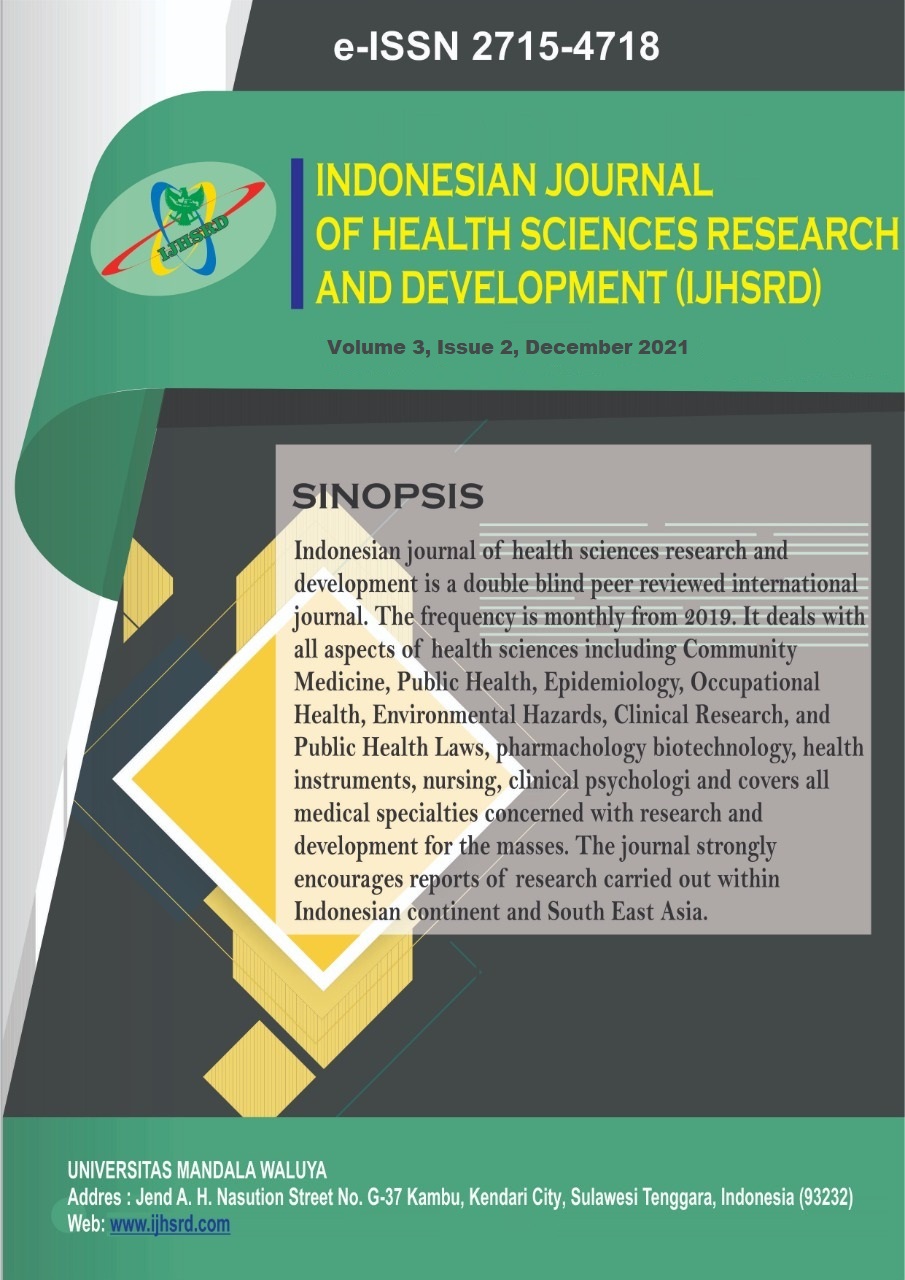Main Article Content
Abstract
Background: Dengue Hemorrhagic Fever is a mosquito-borne infectious disease found in tropical and subtropical areas around the world. In recent years, transmission has increased especially in urban and semi-urban areas and has become a major international public health concern. The aim of this study was to analyze the effect of the movement of one house and one larva monitor on the presence of larvae in Watubangga sub-district, Watubangga sub-district.
Methods: This type of research is quantitative research with a pre-experimental approach. The population in this study were all heads of families living in the Watubangga Village area as many as 608 families. The sample in the study was partly from the heads of families who lived in Watubangga Village as many as 236 respondents. The sample was selected using a systematic random sampling method. Data were collected through questionnaires and observation sheets and then analyzed descriptively and inferentially.
Result: This study shows that there is an effect of the movement of one house and one larva monitoring interpreter on the presence of larvae in Watubangga Village where a p-value of 0.000 is obtained.
Conclusion: After the intervention with the one house movement, one larva monitoring interpreter, there was an increase in community skills in efforts to prevent dengue hemorrhagic fever. Therefore, it is hoped that the one house one larva monitoring program can be implemented throughout the territory of the Republic of Indonesia.
Keywords
Article Details

This work is licensed under a Creative Commons Attribution-ShareAlike 4.0 International License.
References
- WHO. Dengue Control. Geneva. WHO. 2016
- Ministry of Health RI. Indonesia Health Profile 2019: Ministry of Health RI; 2020.
- Health Office of Southeast Sulawesi. Health Profile of Southeast Sulawesi Province. Kendari; 2020.
- Kolaka District Health Office. Kolaka District Health Profile. 2020.
- Watubangga Health Center. Watubangga Health Center Profile. 2020.
- .Tira Ds, Apipideli D, Landi Sjjppmklk. Assistance and Examination of Aydes Aigepty Mosquito Larvae in Dengue Fever Endemic Area, Kelapa Lima District, Oesapa Village-Kupang City. 2020;1(1):26-33.
- Hulu Vt, Pane Hw, Tasnim T, Zuhriyatun F, Munthe Sa, Hadi S, Et Al. Public Health Promotion: Our Writing Foundation; 2020.
- Mahawati E, Pakpahan M, Wulandari F, Purba Dh, Sari M, Unsunnidhal L, Et Al. Environmentally Based Diseases: Our Foundation for Writing; 2021.
- Try C. Training on larva monitoring in the East Artaraya Berangas Complex Community Group: Muhammad Arsyad Al Banjarmasin Islamic University Kalimantan, Banjarmasin. 2019.
- Marina R, Ariati. The Role of Jumantik Cadre Assistance on Community Actions Related to the Presence of Aedes Sp larvae in the Kec. Pekanbaru City Umbrella. 2021;1(1):1013-23.
- Widiyanto P, Widyantoro T, Ulva S, Ningrum Mp, Safitri Najje. Implementation of the One House One Jumantik (G1r1j) Movement to Create a Dengue Fever-Free Environment. 2021;2(1):15-22.
- Dwantara Pw, Dinata A. The Maya Index Analysis On Dengue Patient Household In Banjar City, 2012. Balaba: Journal of Research and Development on Disease Control with Animal Sourced Banjarnegara. 2015;11(1):1-8.
- Mangidi Magt, Sunarsih S, Jayadipraja Eaja-Stphsj. The Effect of Triggering on the Larval Free Rate (Abj) in the Village of Rahandouna, Kendari City. 2019;11(2).
- Harun A, Saraswati Ps, Mangidi Magtjajomp, Practice C. Relationship Between Family Support And Work Status To The Utilization Of Ncd Integrated Post In The Work Area Of Barangka Health Center, Buton District. 2020:1-5.
- Azhari Ar, Darundiati Yh, Dewanti Nayjh. A Study of Correlation Between Climate Factors and the Incidence of Dengue Hemorrhagic Fever in 2011-2016. 2017;1(4):163-75.
- Hulu Vt, Tasnim T, Sitorus S, Parinduri L, Sitorus E, Chaerul M, Et Al. Environmental Health: Our Writing Foundation; 2020.
